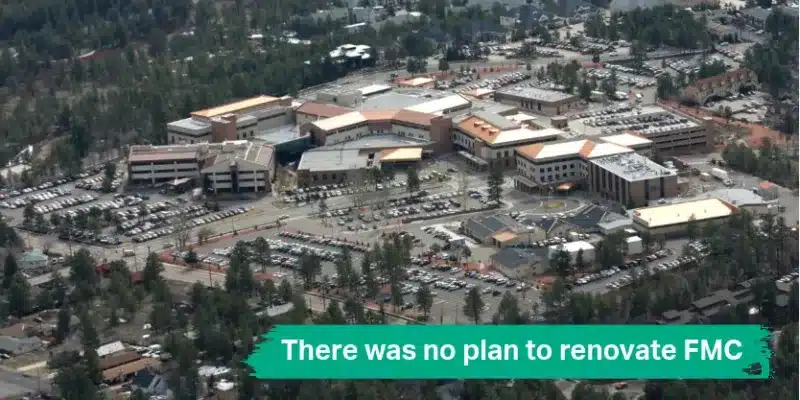Opponents of the new hospital frequently say Northern Arizona Healthcare had a plan to renovate FMC in 2019 and demands NAH implement that “plan” rather than build the new hospital this region needs. Every time they do so, they are making conclusions that are not supported by the document they cite.
They are referencing a 2018 NAH-system-wide strategic planning document, not a tangible plan to renovate FMC to meet the needs of the region in 2050. Strategic plans are visioning documents, they set out broad sweeping goals and there is no itemized plan for comprehensive renovation at FMC in the document.
In strategic planning, organizations first set out their vision, then they identify a few broad measures that speak to the goal. There is always more work that follows the initial outlay of ideas and that’s true with NAH’s 2018 strategic plan, too.
In truth, a total of five pages of the 103-page document discuss facilities, and two of those pages are dedicated exclusively to Cottonwood and Sedona facilities. There is one relevant page in the document with a table that mentions creating an “efficient, state of art campus over long term with facilities aligned with patient and staff needs.” It goes on to include a very short list of very vague tactics, including expanding the ambulatory footprint, adding surgical capacity through an outpatient facility, constructing 100% private rooms and a new patient tower. There are no drawings of how or where such a patient tower could be built, nor any other rough or specific drawings of how to expand the capacities and size of FMC.
After the strategic plan was drafted, NAH did further work to analyze the ideas regarding FMC and the strategies they meant to address. First and foremost, this included engaging a healthcare architect to assess feasibility of expansion as well as cost. Upon this deeper and expert analysis, NAH determined adding a new patient tower on site at FMC and making all rooms private would result in fewer beds at construction’s completion, as well as massive disruption to care across FMC for many years. This did not meet our strategic direction to serve the region through 2050.
It’s not true to say that NAH had a comprehensive plan for expanding in place.
Other ideas mentioned in the 2018 strategic visioning document include expanding ambulatory capacity and outpatient surgery locations. NAH has completed these projects and still understands the needs of the region for the next several decades will not be met by our current facilities.
NAH had a list of aspirational ideas for the future at FMC, and when we conducted detailed analysis, those were deemed not sufficient to meet the region’s needs. Accusing NAH of lying is, itself, twisting the truth of what the document says. There is no plan to renovate FMC, there is a confidential document that mentions a few ideas. Responsible organizations do further research before setting out an itemized, detailed plan. NAH should not be punished for taking a normal decision-making process to analyze our ideas, learn they weren’t effective and then not proceed with an ineffective idea.
It is the natural flow of large organization decision making to follow the process laid out above. NAH has analyzed the region’s needs, studied options and crafted a plan to meet them. The idea that we can expand in place on our current campus ignores the facts we’ve laid out about how that’s not possible if we also aim to meet modern medical standards and grow with the region.
We’ve been serving our neighbors, visitors and families for 90 years. We aim to serve this community for the next 90 years. Because NAH operates the only Level I Trauma Center north of Phoenix, serving all trauma cases in northern Arizona and beyond, it must be a community goal that the highest quality health care remains available in Flagstaff.
For more information on the new hospital, read:
We want to build the hospital this community needs
Why the region needs a new hospital
How we’re staffing a new facility
How our project is 100% privately funded
Why more single rooms are needed to meet current care standards
